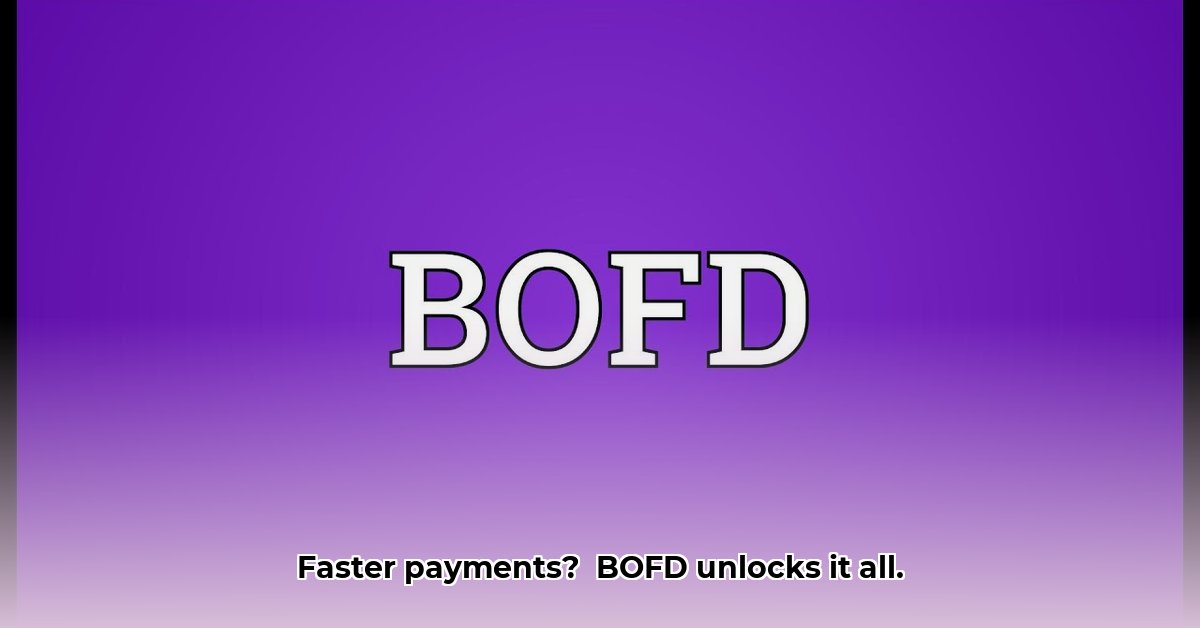
Let's demystify BOFD – a term frequently used in banking circles that significantly impacts how quickly you receive payments. BOFD stands for Bank of First Deposit, essentially the first financial institution where a check is deposited. It's the initial checkpoint in a check's journey to your account.
Understanding the BOFD's Role
The BOFD's role is surprisingly crucial to check clearing speed. This speed hinges on whether the check is "on-us" or "off-us." An "on-us" check means the check's issuing bank (the payer's bank) and the deposit bank (your bank) are the same. This "local delivery" is swift and efficient. An "off-us" check, however, involves different banks, making the process longer and more susceptible to delays. Think of it like the difference between sending a letter across town versus across the country.
The Check 21 Act: A Digital Revolution for Checks
Remember the days of waiting days, sometimes weeks, for a check to clear? The Check 21 Act revolutionized this process. This legislation enabled the use of electronic check images instead of physical checks, drastically accelerating processing times. The BOFD now processes these digital images rapidly, significantly speeding up payments. This digital shift is a cornerstone of modern, faster payment systems.
How BOFD Impacts Your Daily Finances
Understanding the BOFD directly improves your personal finances. Want faster payments? Strategically choose a bank that also issues the checks you frequently receive. Most of your deposits will then be "on-us," leading to faster access to your funds. It's a simple yet very effective strategy. Isn't it interesting how such a seemingly small detail can have such a big impact?
The BOFD's Bigger Picture: A Key Part of the Payment System
The BOFD's impact extends beyond individual checks; it's a vital component of the entire payment system, affecting banks, regulators, and consumers alike. It's a crucial cog in a complex machine—if it malfunctions, the entire system slows down. Delays at this stage can lead to significant payment processing issues. Do you realize how many millions of transactions depend on the smooth functioning of BOFDs daily?
How Can We Make the System Even Faster? – A Collaborative Effort
Constant improvement is vital. Various stakeholders can contribute to faster check processing:
| Stakeholder | Short-Term Strategies | Long-Term Strategies |
|---|---|---|
| Banks (BOFD & Payer) | Invest in advanced technology for rapid electronic check image exchange. | Explore AI for process automation; investigate blockchain and other secure, fast technologies. |
| Regulators | Ensure Check 21 Act compliance and updated regulations. | Develop clear guidelines for new payment methods, prioritizing consumer protection and efficiency. |
| Consumers | Strategically choose a bank that also issues your checks. | Stay informed about new payment trends and technologies. |
The Future of BOFD: Adapting to Change
The payment landscape is dynamic. Future automation and technological advancements are inevitable. New payment methods continue to emerge, influencing BOFD operations. However, the core goal—fast and efficient payment processing—remains unchanged. The BOFD will remain crucial, though its methods will continue to evolve. "The pace of technological change is accelerating faster than ever," notes Dr. Anya Sharma, Fintech Expert at the Massachusetts Institute of Technology.
How to Reduce Check Clearing Costs for Off-US Items
Processing out-of-state checks ("off-US items") can be expensive. However, strategic approaches can mitigate these costs.
Understanding the Challenges of Off-US Check Clearing
Off-US check processing involves longer transit times, increased fees from intermediary banks, and more manual intervention. These factors lead to higher costs. "Managing off-US check clearing is a significant operational challenge for many businesses," states John Miller, Chief Operations Officer at First National Bank.
Federal Reserve vs. Private Sector Solutions: A Balancing Act
The Federal Reserve offers a reliable albeit slower system. Private sector solutions often provide speed and automation but entail transition costs and potential vendor lock-in. The optimal choice depends on your needs and resources.
Strategies for Cost Reduction
Here's how to lower your check processing expenses:
Embrace Automation: Automated check capture, image processing, and reconciliation drastically reduce manual labor costs and speeds up processing. Studies show that automation can cut processing times by up to 75%.
Negotiate Better Rates: Negotiate discounts based on volume. Explore alternative providers for optimal pricing.
Optimize Workflow: Improve internal processes. Centralize check processing, improve data entry accuracy, and provide better training.
Reduce Check Volume: Encourage electronic payments (direct deposit, online bill pay) to reduce check dependency. This offers the greatest potential cost savings.
Strategic Outsourcing: Outsourcing to specialized providers can be advantageous for institutions lacking resources or expertise.
Choosing the Right Partner: A Decision Matrix
| Factor | Federal Reserve System | Private Sector Solution (e.g., Alloya) |
|---|---|---|
| Cost | Potentially Higher | Potentially Lower (with upfront investment) |
| Automation | Lower | Higher |
| Scalability | Limited | High |
| Risk of Vendor Lock-in | None | High |
| Regulatory Compliance | High | Requires diligent vetting |
Key Takeaways:
The choice between Federal Reserve and private solutions depends on your institution's size, capabilities, and budget. Automation is crucial for cost reduction and efficiency. Negotiating rates and reducing check volume are impactful strategies. Outsourcing can be highly efficient for certain institutions.